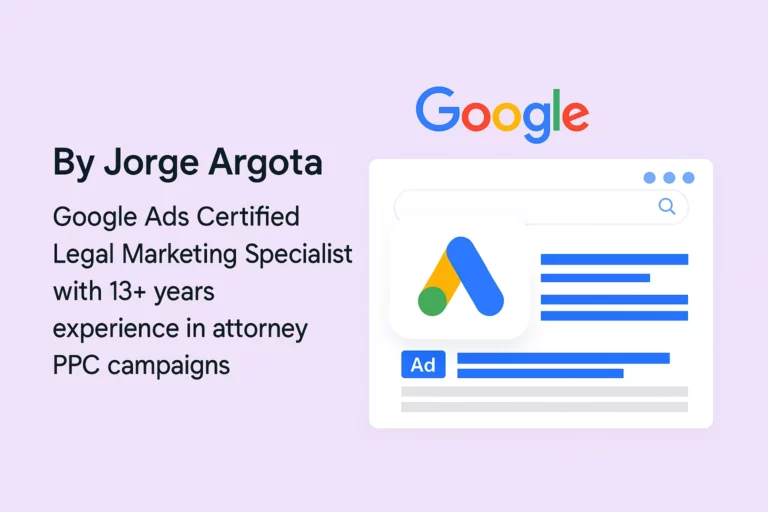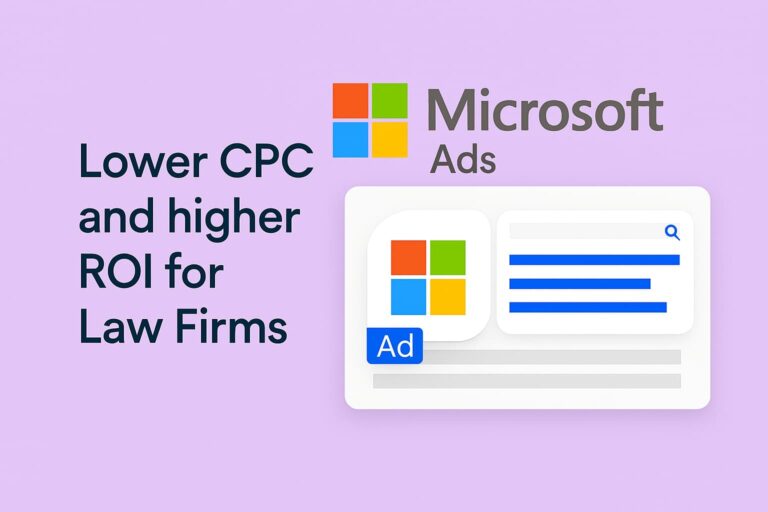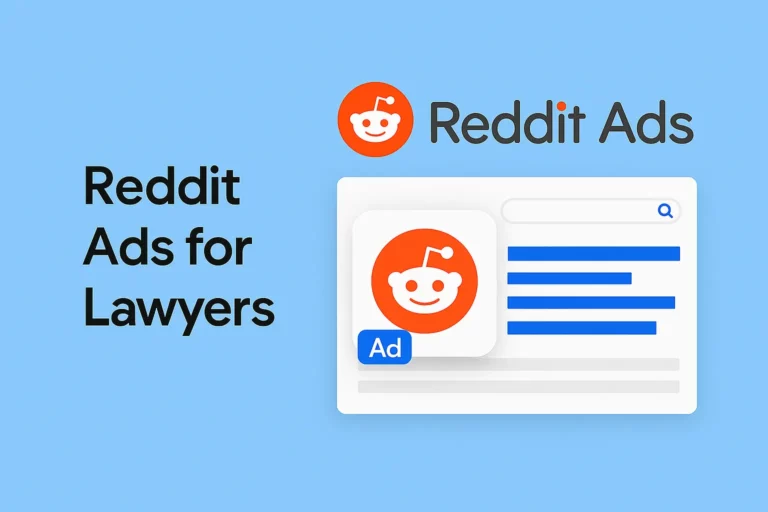English / Spanish
Google Ads Budgeting and ROI for Law Firms
By Jorge – Digital Marketing Professional with Hands-On Experience in PPC for Legal Services
Who, How, and Why
- Author: Jorge, a marketer who has guided multiple law practices (from personal injury to corporate law) in setting up and optimizing Google Ads.
- How This Was Created: Drawing from my experience and real-world campaign data as well as best practices gleaned from both official Google Ads resources and recognized legal marketing authorities.
- Why: To ensure attorneys can budget effectively, track profitability, and stay compliant while making the most of their ad spend.
Disclaimer: This information is general and not legal advice. Always follow your local bar regulations regarding advertising and consult qualified professionals for specific guidance.
A. Why Budgeting and ROI Matter for Law Firms
1. Significant Investment Requirements
Legal advertising typically demands higher investments than many other industries. Establishing a proper budget is critical as law firms often face challenging financial decisions: balancing case acquisition costs against long-term profitability. Without clear budgeting, firms risk allocating resources ineffectively, potentially underfunding promising campaigns or overspending on underperforming ones.
2. High Competition in the Legal Sector
Legal keywords—especially in competitive practice areas like personal injury or criminal defense—can have some of the highest Cost Per Click (CPC) ranges on Google. With CPCs sometimes exceeding $50, the margin for error is slim. Careful budgeting and ROI tracking help you justify every dollar spent.
Key Metrics for Setting Your Legal Advertising Budget
- Cost Per Click (CPC) – How much you pay for each click. For highly competitive regions (e.g., large cities) and practice areas (e.g., personal injury), CPC can range from $20 to $150.
- Click-Through Rate (CTR) – Indicates ad relevance; 3–5% is common for well-structured legal ads.
- Conversion Rate (CVR) – The percentage of clicks that become leads or consultations. For lawyers, 5–15% is often achievable with a solid landing page.
- Cost Per Acquisition (CPA) – The average cost to acquire one lead or client inquiry.
- Return on Ad Spend (ROAS) – Total revenue from ads ÷ ad spend.
- Return on Investment (ROI) – A holistic measure of profitability once you factor in all expenses (ad spend + overhead).
Tip: Conversion tracking is essential. Whether you’re tracking form fills for a free consultation or calls from ads, you need accurate data to calculate ROI.
Benchmarks & Budgeting Ranges for Different Practice Areas
Below is a rough guideline of ROI expectations by practice type, recognizing that every firm’s overhead, geographic area, and referral fees will differ:
+--------------------------------+---------------------------+
| Practice Area | Typical ROI Range |
+--------------------------------+---------------------------+
| Personal Injury | 300% – 700%+ |
| Family Law / Divorce | 200% – 500% |
| Estate Planning | 150% – 400% |
| Corporate / Business Law | 200% – 500% |
| Criminal Defense | 200% – 450% |
| Immigration Law | 180% – 400% |
+--------------------------------+---------------------------+
These ranges assume strategic keyword bidding and effective landing pages. High ROI is possible but requires continuous optimization.
Three-Step Budgeting Framework for Law Firms
Step 1: Define Clear Goals
- Personal Injury Firm: “We want 10 high-quality leads per month, each potentially worth $5,000–$10,000 in fees.”
- Estate Planning Practice: “We aim for 15 new consultation bookings monthly.”
- Corporate Law: “We want to attract 5 large corporate clients per quarter.”
Step 2: Research Keyword Costs
Use Google’s Keyword Planner to see average CPC in your geographic area and compare competitor ads. If your primary keywords (e.g., “personal injury lawyer near me”) run $75 per click, factor that into your daily budget.
Step 3: Establish an Initial Budget
A straightforward formula for monthly ad spend: Monthly Budget=
A straightforward formula for monthly ad spend:
Monthly Budget = (Clicks per Day) × (Avg CPC) × 30Of course, not every firm can afford that. Start with a comfortable number, run for at least 2–4 weeks, then refine based on data.
How to Calculate ROI
Legal services often have high lifetime value (LTV), so you must factor in closed deals vs. lead volume. Here’s the formula in a more readable format:
Legal services often have high lifetime value (LTV), so you must factor in closed deals vs. lead volume. Here’s the ROI formula:
Where:
- Total Revenue from Ads: The actual value of cases/settlements from clients acquired through ads
- Total Costs = Ad Spend + Overheads (agency fees, landing page creation, etc.)
Important: For accurate ROI calculation, track which clients came through your ads and the actual revenue they generated – not just the leads or clicks.
Example: Small Firm Personal Injury Campaign
Total Revenue from Ads (settlements attributable to Google Ads leads): $60,000
- Ad Spend: $10,000
- Overheads: $2,000 (e.g., agency fees, landing page design)
- Total Costs = $12,000
A 400% ROI means you generate $4 in net profit for every $1 spent.
BONUS: Use Visual Elements to Enhance Your ROI Analysis
In your final presentation or internal reports, consider adding:
Create a Monthly Spend vs. Leads Chart
What It Shows: A dual-axis line chart that tracks two key metrics over time:
- Your daily or weekly ad spend (typically shown as a blue line)
- The number of leads or consultations generated (typically shown as a red line)
Example:
Here’s how this chart looks in Google Data Studio (Looker Studio):
Monthly Data:
| Month | Ad Spend | Leads | CPA |
|---|---|---|---|
| January | $5,000 | 15 | $333 |
| February | $7,500 | 25 | $300 |
| March | $8,200 | 28 | $293 |
| April | $8,600 | 30 | $287 |
| May | $9,100 | 33 | $276 |
| June | $9,500 | 36 | $264 |
Key Insights:
- As spend increased from January to June, leads consistently increased as well.
- The steady improvement in CPA (from $333 to $264) shows increasing campaign efficiency.
- The relationship isn’t perfectly linear—diminishing returns appear as spend increases.
Implementation Note: In Google Data Studio, you can add annotations to mark when major campaign changes were made (e.g., new ad copy in March, landing page updates in May) to connect optimization efforts with performance improvements.
Why It’s Valuable:
- Clearly shows if increased ad spend is resulting in proportional lead growth
- Helps identify seasonal patterns or unexpected performance changes
- Reveals whether there’s a time lag between spending changes and lead generation
How to Create It:
- In Google Data Studio (Looker Studio):
- Create a new report and connect your Google Ads data source
- Add a time series chart from the chart menu
- Select date range for X-axis
- Add Cost metric for your first Y-axis
- Add Conversions metric for your second Y-axis
- Set appropriate date range (last 90 days recommended for start)
- In Excel/Google Sheets:
- Export campaign data from Google Ads (include date, cost, conversions)
- Select your data and insert a line chart
- Right-click on the Conversions data series and select “Format Data Series”
- Choose “Secondary Axis” to create the dual-axis chart
- Add chart title and axis labels for clarity
- Viewing Frequency: Review this chart weekly to spot trends and make budget adjustments based on lead generation efficiency.
Cost per Lead Over Time
What It Shows: A bar chart tracking your Cost Per Acquisition (CPA) over time.
Here’s how this chart would look in Google Data Studio (Looker Studio):
Weekly Data:
| Week | Cost Per Acquisition | Status |
|---|---|---|
| Week 1 | $345 | Above Target |
| Week 2 | $338 | Above Target |
| Week 3 | $320 | Above Target |
| Week 4 | $310 | Above Target |
| Week 5 | $295 | Below Target |
| Week 6 | $285 | Below Target |
| Week 7 | $275 | Below Target |
| Week 8 | $268 | Below Target |
Key Insights:
- CPA has steadily decreased from $345 to $268 over the 8-week period.
- The campaign crossed below the target CPA threshold in Week 5.
- Optimizations made in Weeks 3–4 (landing page redesign, negative keywords) had a significant impact.
- The improvement rate is beginning to flatten, suggesting we’re nearing optimal efficiency.
Implementation Note: Add a target line at your goal CPA (e.g., $300) to quickly see when you cross the efficiency threshold. Color bars red above target and green below for instant visual analysis.
Key Insights:
- CPA has steadily decreased from $345 to $268 over the 8-week period
- The campaign crossed below the target CPA threshold in Week 5
- Optimizations appear to be improving efficiency consistently each week
Implementation Note: Add a horizontal reference line at your target CPA to instantly visualize when campaigns cross efficiency thresholds.
Why It’s Valuable:
- Provides clear visualization of campaign efficiency trends over time
- Helps validate whether optimization efforts are working
- Identifies concerning upward trends that require immediate attention
- Allows for quick performance comparison against your cost goals
How to Create It:
- In Google Data Studio (Looker Studio):
- Create a new report and connect your Google Ads data source
- Add a column chart visualization
- Set dimension to Week or Month
- Set metric to Cost/Conversion
- Add a reference line at your target CPA
- Apply conditional formatting to color bars based on target
- In Excel/Google Sheets:
- Organize data with time periods in Column A and CPA in Column B
- Calculate CPA for each period (Total Cost ÷ Total Conversions)
- Select data and insert a column chart
- Add a horizontal line at your target CPA
- Format bars using conditional formatting
- Viewing Frequency: Review bi-weekly to monitor the impact of campaign optimizations on acquisition costs.
Keyword Performance Pie Chart
What It Shows: A pie or donut chart showing which keywords consume your budget or drive your conversions.
Here’s how this chart would look in Google Data Studio (Looker Studio):
Spend Distribution
Conversions Distribution
Keyword Data:
| Keyword | Share of Spend | Share of Conversions | Value Index |
|---|---|---|---|
| “Personal injury lawyer Miami” | 35% | 28% | 0.80 |
| “Car accident attorney near me” | 22% | 31% | 1.41 |
| “Miami injury law firm” | 15% | 14% | 0.93 |
| “Slip and fall lawyer Miami” | 12% | 11% | 0.92 |
| “Truck accident attorney Florida” | 9% | 12% | 1.33 |
| “Other keywords” | 7% | 4% | 0.57 |
Key Insights:
- “Car accident attorney near me” delivers the best ROI with 31% of conversions while using only 22% of spend.
- “Personal injury lawyer Miami” is the most expensive keyword (35% of spend) but yields only 28% of conversions.
- “Truck accident attorney Florida” shows strong potential with a high value index of 1.33.
- The “Other keywords” segment has poor performance and should be evaluated for potential cuts.
Implementation Note: Create two companion pie charts side by side—one for spend and one for conversions—to quickly spot misalignments. Keywords with a Value Index above 1.0 warrant increased budget, while those below 1.0 should be optimized or reduced.
Why It’s Valuable:
- Quickly reveals which keywords consume the largest portions of your budget
- Identifies high-performing keywords that deserve increased investment
- Highlights underperforming keywords that may need optimization or reduced bids
- Provides at-a-glance visualization of budget allocation efficiency
How to Create It:
- In Google Data Studio (Looker Studio):
- Create a new report and connect your Google Ads data source
- Add a pie chart visualization
- Set dimension to Keyword
- Set metric to Cost or Conversions
- Apply a filter to show only top 5-7 keywords plus “Other”
- Create a companion chart with the alternate metric for comparison
- In Excel/Google Sheets:
- Export keyword-level data from Google Ads
- Calculate percentage of total for cost and conversions
- Create two pie charts side by side
- Use consistent colors for the same keywords across both charts
- Add data labels showing percentages
- Viewing Frequency: Review monthly when making keyword strategy adjustments and budget allocations.
Important recap of the content
- Many law firms overspend on Google Ads, seeing few qualified leads.
- High CPCs in legal niches mean mistakes can cost thousands—sometimes with zero new clients to show for it.
- Employ a data-driven budget plan, track ROI meticulously, and fine-tune ads/landing pages to convert clicks into profitable cases.
Action Checklist
- Identify Your Legal Niche Goal (e.g., 10 new personal injury leads/month).
- Research CPC (Keyword Planner, competitor ads).
- Set Initial Monthly Budget (e.g., $2,500–$5,000 for smaller local firms, $10,000+ for competitive regions).
- Enable Conversion Tracking (form submissions, call tracking, live chat inquiries).
- Monitor Key Metrics (CPC, CTR, CVR, CPA, and ultimate ROI).
- Refine & Scale (Once ROI is positive, expand your budget and target new practice areas).
Final Thoughts & Next Steps
Law firm advertising on Google Ads is uniquely challenging due to high competition and strict marketing regulations. However, with a disciplined approach to budgeting and clear ROI tracking, you can transform your ad spend into a valuable investment—bringing in clients, cases, and growth for your firm.
Remember: Always review your ads and landing pages for ethical compliance with your state bar and local advertising regulations. In the legal domain, credibility, trust, and accuracy are crucial to your long-term success.
Ready to Get Started?
- Begin Small: Allocate a test budget for 2–4 weeks.
- Analyze Daily/Weekly: Keep a close eye on CPC, CPA, and lead quality.
- Iterate & Expand: Scale up your investment once you see a solid return.
About the Author
I’m Jorge, a digital marketer with years of experience running successful Google Ads for various law firms. I specialize in crafting compliant, high-ROI campaigns that capture the right clientele for your practice.
Disclaimer: The strategies and insights here are for educational purposes and should not be taken as legal advice. Always consult marketing and legal professionals familiar with your jurisdiction’s advertising rules for tailored recommendations.



